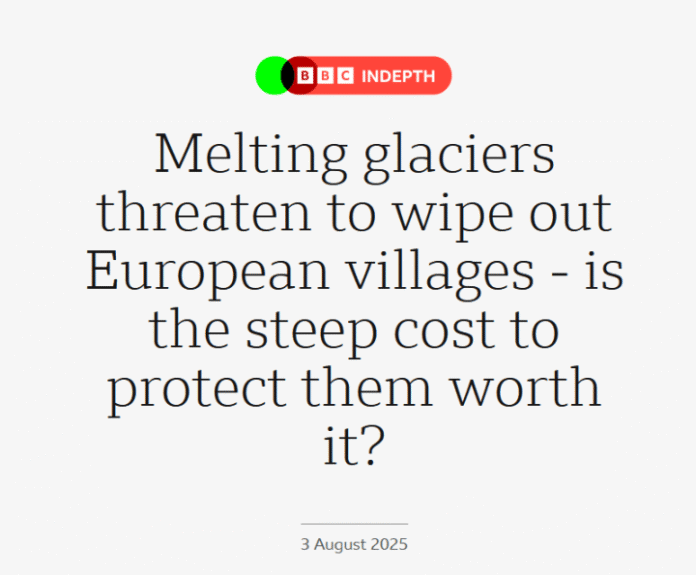From NOT A LOT OF PEOPLE KNOW THAT
By Paul Homewood
h/t Philip Bratby
In a small village in Switzerland’s beautiful Loetschental valley, Matthias Bellwald walks down the main street and is greeted every few steps by locals who smile or offer a handshake or friendly word.
Mr Bellwald is a mayor, but this isn’t his village. Two months ago his home, three miles away in Blatten, was wiped off the map when part of the mountain and glacier collapsed into the valley.
The village’s 300 residents had been evacuated days earlier, after geologists warned that the mountain was increasingly unstable. But they lost their homes, their church, their hotels and their farms.
Lukas Kalbermatten also lost the hotel that had been in his family for three generations.”The feeling of the village, all the small alleys through the houses, the church, the memories you had when you played there as a child… all this is gone.”
Though the disaster shocked Switzerland, some two thirds of the country is mountainous, and climate scientists warn that the glaciers and the permafrost – the glue that holds the mountains together – are thawing as the global temperature increases, making landslides more likely. Protecting areas will be costly.
https://www.bbc.co.uk/news/articles/cj4w9ggzxv4o
BBC INDEPTH? Don’t make me laugh.
A properly objective report would have also mentioned the downhill march of Swiss glaciers in the Little Ice Age.
My review of Brian Fagan’s excellent book, The Little Ice Age, gives a flavour of just how dreadful those times were. [Sections in italics are direct quotes]:
We tend to regard alpine landscapes today such as those in Switzerland as being picturesque and think that the people there live in a beautiful rural idyll. It was not always so. In the 16th Century the occasional traveller would remark on the poverty and suffering of those who lived on the marginal lands in the glacier’s shadow. At that time Chamonix was an obscure poverty stricken parish in “a poor country of barren mountains never free of glaciers and frosts…half the year there is no sun…the corn is gathered in the snow…and is so mouldy it has to be heated in the oven”. Even animals were said to refuse bread made from Chamonix wheat. Avalanches caused by low temperatures and deep snowfall were a constant hazard. In 1575 a visitor described the village as “a place covered with glaciers…often the fields are entirely swept away and the wheat blown into the woods and onto the glaciers”.
In 1589 the Allalin glacier in Switzerland descended so low that it blocked the Saas valley, forming a lake. The moraine broke a few months later, sending floods downstream. Seven years later 70 people died when similar floods from the Gietroz glacier submerged the town of Martigny.
As the glaciers relentlessly pushed downslope, thousands of acres of farm land were ruined and many villages were left uninhabitable such as La Bois where a government official noted “where there are still six houses. all uninhabited save two, in which live some wretched women and children…Above and adjoining the village there is a great and horrible glacier of great and incalculable volume which can promise nothing but the destruction of the houses and lands which still remain”. Eventually the village was completely abandoned.
The same official visited the hamlet of La Rosiere in 1616 and found “The great glacier of La Rosiere every now and then goes bounding and thrashing or descending…There have been destroyed 43 journaux of land with nothing but stones and 8 houses, 7 barns and 5 little granges have been entirely ruined and destroyed”.
Alpine glaciers, which had already advanced steadily between 1546 and 1590, moved aggressively forward again between 1600 and 1616. Villages that had flourished since medieval times were in danger or already destroyed. During the long period of glacial retreat and relative quiet in earlier times, opportunistic farmers had cleared land within a kilometer of what seemed to them to be stationary ice sheets. Now their descendants paid the price with their villages and livelihoods threatened.
Between 1627 and 1633 Chamonix lost a third of its land through avalanches, snow, glaciers and flooding, and the remaining hectares were under constant threat. In 1642 the Des Bois glacier advanced “over a musket shot every day, even in August”.
By this time people near the ice front were planting only oats and a little barley in fields that were under snow for most of the year. Their forefathers had paid their tithes in wheat. Now they obtained but one harvest in three and even the grain rotted after harvesting. “The people here are so badly fed they are dark and wretched and seem only half alive”.
In 1715 the village of Le Pre-du-Bar vanished under a glacier caused landslide. The glacial high tide in the Alps came around 1750 and gradually the glaciers began their retreat, much to the relief of the people who lived there.
The BBC might like to consider that none of these villages were there three hundred years ago because the glaciers were there instead.
I somehow doubt anybody in Switzerland would want a return to those days.
Related
Discover more from Watts Up With That?
Subscribe to get the latest posts sent to your email.
